Blueberries - an incredibly useful berry, thanks to its rich composition, it has gained immense popularity among adherents of a healthy diet. For a long time, blueberries were considered northern exotic, but thanks to the work of breeders who cultivated garden varieties, this berry can now grow on its own plot each. To do this, it is necessary to consider the features of garden blueberries, the rules of planting and care, as well as the most suitable varieties for growing in the Moscow region.
Table of contents
How does a garden blueberry differ from its wild relative?
Wild Blueberry grows only in the northern hemisphere, it can be found in Iceland, Great Britain, North America and in the northern and far eastern regions of Russia. The plant is very unpretentious, and in nature prefers to grow in the marshland. Easily withstands low temperatures, so it feels great even in the tundra.
- Wild blueberries
- Garden blueberries
Garden blueberries inherited simplicity and frost resistance. Besides, some characteristics of the plant have been improved by breeders:
- Shoots became higher (70 cm instead of 25-30 cm), and the number of berries on one stem increased, which had a positive impact on the yield of the plant. It reaches 12 kg from a bush.
- Homemade berries are large and fleshy, in nature, this can not be found.
- Fruiting garden varieties begin already on 2-3 year, the wild variety gives fruit only for 15 year of life.
- Cultivated varieties resistance to pests and diseases.
But in some respects the garden plant is inferior to its progenitor:
- Fruit usefulness. Berry grown in natural conditions will always contain more vitamins than home.
- Lifespan. The bush of wild blueberry bears fruit for more than 50 years, but the garden one cannot boast with such longevity. A home plant must be replanted every 6 years with cutting of new cuttings, otherwise the yield will fall sharply and the fruits will be ground.
In any case, planting blueberries in his garden is a profitable event, especially considering the market value of fresh berries. Yes, and in the care of the plant is absolutely unsightly.
Planting garden blueberries in spring and autumn
The success of the landing depends primarily on the correct location. Where to plant this plant? Blueberries need to choose a plot with good illumination and protection from the wind.
Be sure to check the level of acidity of the soil. The plant requires acidic soil with indicators pH 3.5-4.5. If your soil does not meet the requirements, it can be acidified. For this suitable colloidal sulfur or battery electrolyte (sulfuric acid only). 1 ml of electrolyte, diluted in 1 liter of water, lowers the soil pH by 2 points.
Another important point - the site must be restedthat is, over the past few years nothing should have been grown on it.
Suitable for planting, both spring and autumn. But spring planting is preferable, as it allows the plant to get strong enough for the winter.
When planting blueberries in the spring, you need to have time to do it before the buds swell. For Moscow region is the middle of April. It is better to buy a seedling in a pot, its root system will be more viable. Before planting, place the pot in a container of water on 30 minutesthen get a young plant, straighten the roots and gently clean them from the ground.

The landing procedure itself is as follows:
- Dig a hole 50 cm by the depth. When planting several plants at once, between holes it is necessary to make a distance of 50 cm for varieties of undersized and 1 meter for tall ones.
- Loosen the bottom of the fossa and put there a peat blended with sawdust and pine needles. Then add sulfur in the amount of 50 g and mix everything thoroughly again. Thus, ideal sour conditions will be created in which blueberries will actively develop.
- Place the seedling in the hole, straighten it roots and fill it with primer.
- Shower and mulch heavily using conifer sawdust.
In the future, seedlings require watering every 2 weeks. In this case, the water must be enriched with citric acid or apple cider vinegar (20 g per 5 l of water).
If you nevertheless decided to plant the plant in the fall, then it should be done a month before the steady cold, that is, during October. The technology of autumn planting includes all the same actions., but at the end, pruning of one-year-old seedlings is still required Use a shear to remove weak twigs, and cut them strong in half.
Under all conditions, blueberries will quickly grow and next year we will delight you with the first small crop. And in order to further yield a high level, the plant needs to ensure proper care.
Care of an adult plant, especially growing
Caring for blueberries includes standard procedures.
Watering
It is needed every 2 weeks, even if the weather is rainy. And in the hot dry period, the plant should be moistened 2 times a day - in the morning and in the evening, when the sun's rays are not too scorching. Water rate - 1 bucket on a bush.
Soil loosening
It needs to be done several times per season. It should be borne in mind that the root system of blueberries is located close to the surface, about 20 cm. Therefore, it is not necessary to penetrate into the ground deeper than 10 cm.
Weeding
Weeds interfere with the root system to get food in the required amount, get rid of them regularly.
Feedings
Fertilizers must be applied in early spring. The easiest way to stimulate plant growth with superphosphate, zinc sulphate, ammonium sulphate, potassium sulphate and magnesium sulphate.
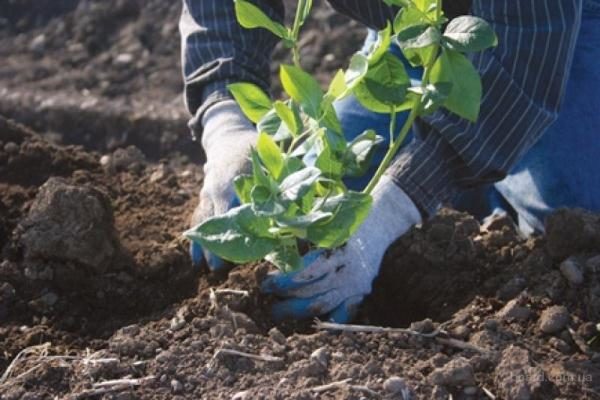
Nitrogen fertilizers are applied in 3 stages:
- in the period of swelling of the kidneys in early spring;
- in the beginning of May;
- At the beginning of June.
If you carefully observe the plant, it will tell you what kind of fertilizer you need. If in the spring the leaves become red, phosphates are required. Foliage shredded and faded - a sign of lack of nitrogen. If the upper leaves turn black, there is little potassium in the soil, and yellowness indicates boron deficiency.
Pruning
To harvest every year, during the period of swelling of the kidneys, it is necessary to prune the plant. Bushes, age 2-4 years subject to mandatory spring pruningto form a strong skeleton, and during the fruiting of the branch is not broken off under the weight of the fruit. Pruning are subject to all branches with fruit buds. In plants from 4 years old, all old branches and growths at the base are removed. In summer and autumn, you can additionally get rid of diseased branches. And in the annual bushes need to remove flowers in the spring.
Pest and disease protection
Blueberries, most often, are attacked by kidney mites, aphids and tsvetoeda. Effective kidney tick protection there will be a treatment of the bushes before the blooming of the kidneys with “Nitrafen”, according to the package instructions. To combat aphids the plant must be sprayed several times with "Confidor" or "BI-58".Treatment should begin after swelling of the kidneys every 2 weeks. Flowerbird will help win the drugs "Inta-Vir" and "Fufanon."
Among the diseases of blueberry are:
- Gray rot. Develops with high humidity. Processing helps branches "Eurapenom" (for 1 liter 2 g of funds). For prevention, it is necessary to timely trim and replace the shrubs.
- Monilioz. Infected blueberries look like they are damaged by frost. First of all, it is necessary to remove all the affected parts of the plant, and then treat it with Topaz, according to the instructions.
- Physalosporosis. These are small reddish spots that appear on young twigs. To stop the development of the disease, cut and burn all diseased shoots.
- Stalk cancer. It begins with the appearance of small red spots on the leaves, which eventually grow and become brown. And later on the shoots ulcers begin to appear, which also gradually increase in size. The fight against the disease is the timely cutting and destruction of diseased branches, as well as the treatment with fungicides - “Fundazol” or “Topsin”.It is necessary to make 3 treatments before flowering (every 7 days), and 3 more after harvesting.
Preparing for the winter
Blueberries are resistant to cold and can easily withstand up to -35 degrees, but shelter for the winter she, nevertheless, does not interfere. This is especially true of tall plants, in which branches can freeze during a snowless winter.
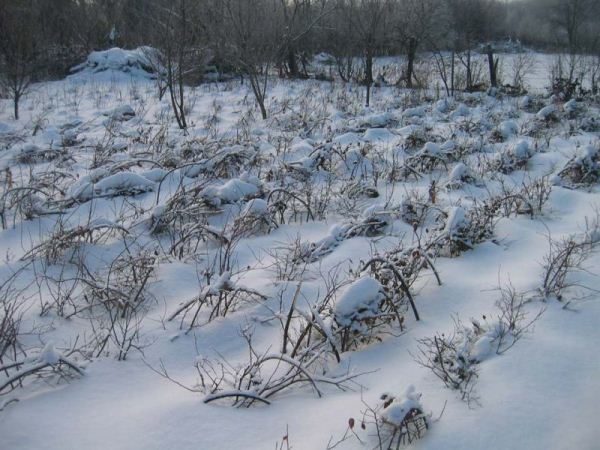
As a shelter is used lapnik, spunbond, burlap, or any other material, but not the plastic film. Ukryvna material is stretched on a frame of arcs or pegs.
It happens that the gardener has planted according to all the rules, and properly takes care of the plant, but the crop is still not there, or the plant dies. The reason for this may be the wrong choice of seedlings.when the variety is not adapted to grow in your area. Therefore, we will further consider what varieties of blueberries will actively develop and bear fruit in the Moscow region.
The best fruit varieties of blueberries for the Moscow region
For the suburban dacha it is worth choosing tall varieties that easily tolerate adverse weather conditions.For this region, American high-quality blueberry varieties are ideal.
Blucrop
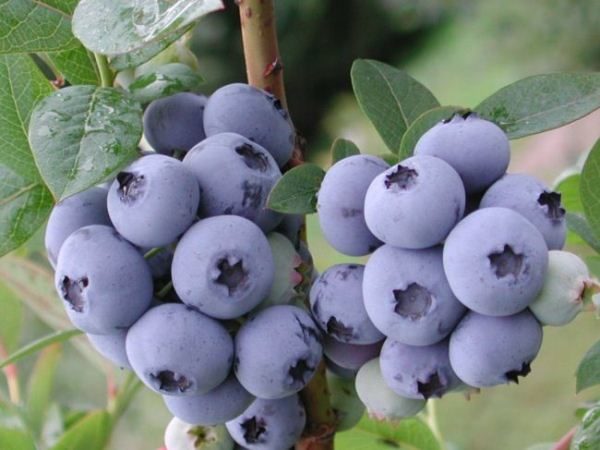
Mid-season variety with a yield of up to 9 kg per shrub. The bush is upright and tall, the height of shoots reaches 2 m. The berries are large, light blue with a tart taste. Resistant to frost, can withstand temperatures as low as 35 degrees. It is also experiencing drought.
Patriot
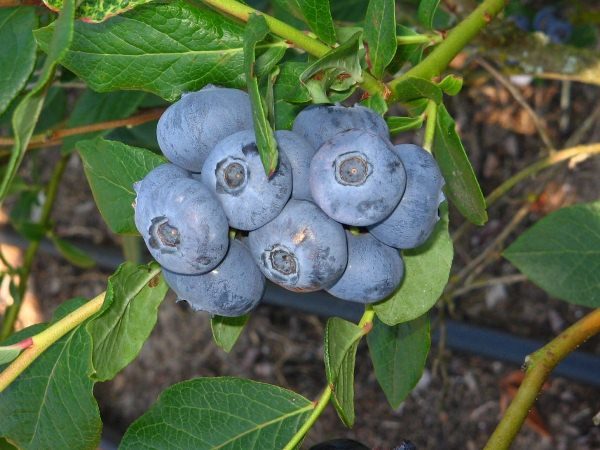
Medium early variety. Shrubs grow to 1.5 meters. The berries are very large, pleasant taste. The variety is high-yielding, prone to fruit overload and thickening, and therefore needs frequent pruning. Self-pollinating, but when other varieties grow nearby, cross-pollination is possible, which has a positive effect on yield. Winter hardiness is high (up to -37).
Northland

The variety is short (1-1.2 m), but with powerful and spreading bushes. It has a good stable yield, ripening by mid-July. From the bush you can collect up to 8 kg fruits. Berries are medium in size, sweet in taste, suitable for long term storage. Small compact bushes have high decorative properties, while unpretentious, and are suitable for growing in the northern regions.
Northblue
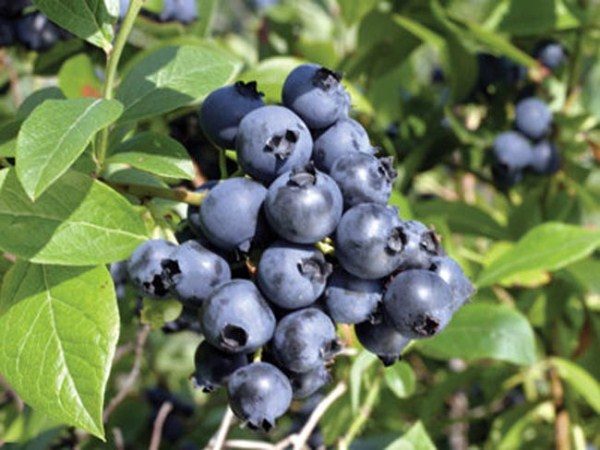
Small (0.6-0.9 m) and dense bushes are valued not only for delicious berries, but also for their high decorative effect. Fruits are large, up to 18 mm in diameter, dark blue, their ripening ends in early August. Possess dessert taste and long shelf life. The resistance of the variety to frost is good, withstands up to -35 degrees.
Any of these varieties will feel great in the climate around Moscow, and with the right care will provide you with abundant crops most useful berries for many years.
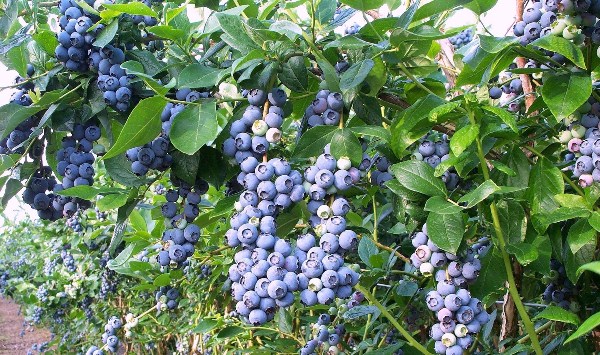


Any of these varieties will feel great in the climate near Moscow, and with proper care will provide you with abundant crops of the most useful berries for many years.